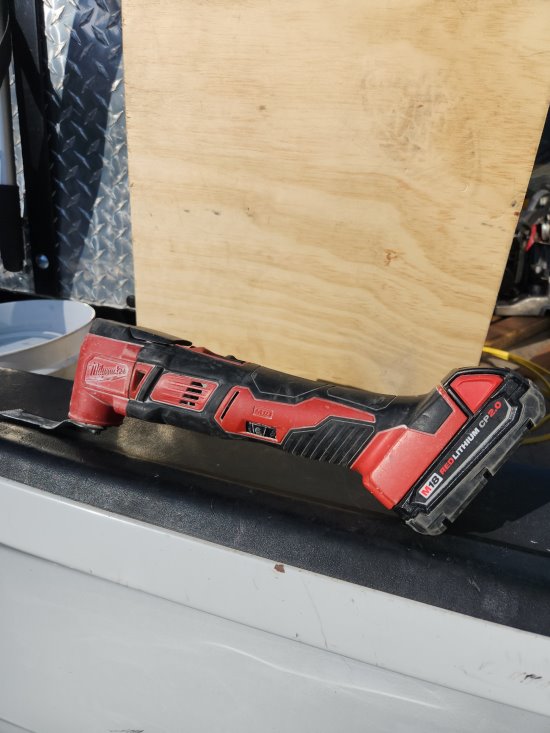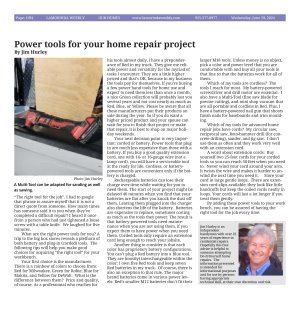| | Published June 19th, 2024
| Power tools for your home repair project
| | | By Jim Hurley |  | | A Multi-Tool can be adapted for sanding as well as sawing. Photo Jim Hurley |
"The right tool for the job". I had to google that phrase to assure myself that it is not a direct quote from someone. How many times has someone said it to you when they've completed a difficult repair? I heard it once from a person who had just tightened a loose screw with a table knife. We laughed for five minutes.
 What are the right power tools for you? A trip to the big box stores reveals a plethora of both battery and plug-in (corded) tools. The following tips will help you make good choices for acquiring "the right tool" for your workbench.
What are the right power tools for you? A trip to the big box stores reveals a plethora of both battery and plug-in (corded) tools. The following tips will help you make good choices for acquiring "the right tool" for your workbench.
 Your first choice is the manufacturer. There is a rainbow of colors to choose from: Red for Milwaukee, Green for Robie, Blue for Makita, and Yellow for DeWalt. What is the difference between them? Price and quality, of course. As a professional who reaches for his tools almost daily, I have a preponderance of Red in my truck. They give me reliable power and versatility for the myriad of tasks I encounter. They are a little higher priced and that's OK, because in my business the tools pay for themselves. If you're buying a few power hand tools for home use and expect to need them less than once a month, a nice Green collection will probably last you several years and not cost nearly as much as Red, Blue, or Yellow. Please be aware that all these manufacturers put their products on sale during the year. So if you do want a higher priced product and your spouse can wait for you to finish that project or make that repair, it is best to shop on major holiday weekends.
Your first choice is the manufacturer. There is a rainbow of colors to choose from: Red for Milwaukee, Green for Robie, Blue for Makita, and Yellow for DeWalt. What is the difference between them? Price and quality, of course. As a professional who reaches for his tools almost daily, I have a preponderance of Red in my truck. They give me reliable power and versatility for the myriad of tasks I encounter. They are a little higher priced and that's OK, because in my business the tools pay for themselves. If you're buying a few power hand tools for home use and expect to need them less than once a month, a nice Green collection will probably last you several years and not cost nearly as much as Red, Blue, or Yellow. Please be aware that all these manufacturers put their products on sale during the year. So if you do want a higher priced product and your spouse can wait for you to finish that project or make that repair, it is best to shop on major holiday weekends.
 Your next decision point is very important: corded or battery. Power tools that plug in are much less expensive than those with a battery. If you buy a good quality extension cord, one with 14- or 16-gauge wire (not a lamp cord), you will have a serviceable tool at the ready for life. Cordless, or battery-powered tools are convenient only if the battery is charged.
Your next decision point is very important: corded or battery. Power tools that plug in are much less expensive than those with a battery. If you buy a good quality extension cord, one with 14- or 16-gauge wire (not a lamp cord), you will have a serviceable tool at the ready for life. Cordless, or battery-powered tools are convenient only if the battery is charged.
 Rechargeable batteries can lose their charge over time while waiting for you to need them. The start of your project might be delayed 40 minutes when you find that your batteries are flat after you knock the dust off them. Leaving them plugged into the charger also shortens the life of the battery. Batteries are expensive to replace, sometimes costing as much as the tools they power. The result is that battery-powered tools need maintenance when you are not using them, if you expect them to have power when you need them. Corded tools only require an extension cord long enough to reach your jobsite.
Rechargeable batteries can lose their charge over time while waiting for you to need them. The start of your project might be delayed 40 minutes when you find that your batteries are flat after you knock the dust off them. Leaving them plugged into the charger also shortens the life of the battery. Batteries are expensive to replace, sometimes costing as much as the tools they power. The result is that battery-powered tools need maintenance when you are not using them, if you expect them to have power when you need them. Corded tools only require an extension cord long enough to reach your jobsite.
 Another thing to consider is that each color has proprietary battery configurations. You can't plug a Red battery into a Blue tool. They are (mostly) interchangeable within the color: I own five Red tools and keep seven Red batteries in my truck. Of course, there is also an exception to that rule. The major brand batteries come in various power levels: Red's smaller M12 batteries don't fit their larger M18 tools. Unless money is no object, pick a color and power level that you are comfortable with and buy all your tools in that line so that the batteries work for all of them.
Another thing to consider is that each color has proprietary battery configurations. You can't plug a Red battery into a Blue tool. They are (mostly) interchangeable within the color: I own five Red tools and keep seven Red batteries in my truck. Of course, there is also an exception to that rule. The major brand batteries come in various power levels: Red's smaller M12 batteries don't fit their larger M18 tools. Unless money is no object, pick a color and power level that you are comfortable with and buy all your tools in that line so that the batteries work for all of them.
 Which of my tools are cordless? The tools I reach for most. My battery-powered screwdriver and drill motor are essential. I also have a Multi-Tool (fine saw blade for precise cutting), and mini shop vacuum that are all portable and cordless in Red. Plus, I have a battery-powered nail gun that shoots finish nails for baseboards and trim moulding.
Which of my tools are cordless? The tools I reach for most. My battery-powered screwdriver and drill motor are essential. I also have a Multi-Tool (fine saw blade for precise cutting), and mini shop vacuum that are all portable and cordless in Red. Plus, I have a battery-powered nail gun that shoots finish nails for baseboards and trim moulding.
 Which of my tools for advanced home repair jobs have cords? My circular saw, reciprocal saw, Roto-hammer drill (for concrete drilling), sander, and jig saw. I don't use them as often and they work very well with an extension cord.
Which of my tools for advanced home repair jobs have cords? My circular saw, reciprocal saw, Roto-hammer drill (for concrete drilling), sander, and jig saw. I don't use them as often and they work very well with an extension cord.
 A word about extension cords: Buy yourself two 25-foot cords for your corded tools so you can reach 50 feet when you need to. Never wind your cord around your arm. It twists the wire and makes it harder to unwind the next time you need it. Store your cord in large gentle loops. There are extension cord-clips available; they look like little handcuffs but keep the coiled cords neatly in loops. Your cords will last a lot longer if you treat them gently.
A word about extension cords: Buy yourself two 25-foot cords for your corded tools so you can reach 50 feet when you need to. Never wind your cord around your arm. It twists the wire and makes it harder to unwind the next time you need it. Store your cord in large gentle loops. There are extension cord-clips available; they look like little handcuffs but keep the coiled cords neatly in loops. Your cords will last a lot longer if you treat them gently.
 By adding these power tools to your work bench, you can be assured of having the right tool for the job every time.
By adding these power tools to your work bench, you can be assured of having the right tool for the job every time. |
 | | Jim Hurley is an independent handyman with over 25 years of experience in residential repairs. Hopefully this free advice is helpful to someone attempting Do-It-Yourself home repairs. The information presented is intended for informational purposes and for use by persons having appropriate technical skill, at their own discretion and risk. | | | | | | | | | | | |



